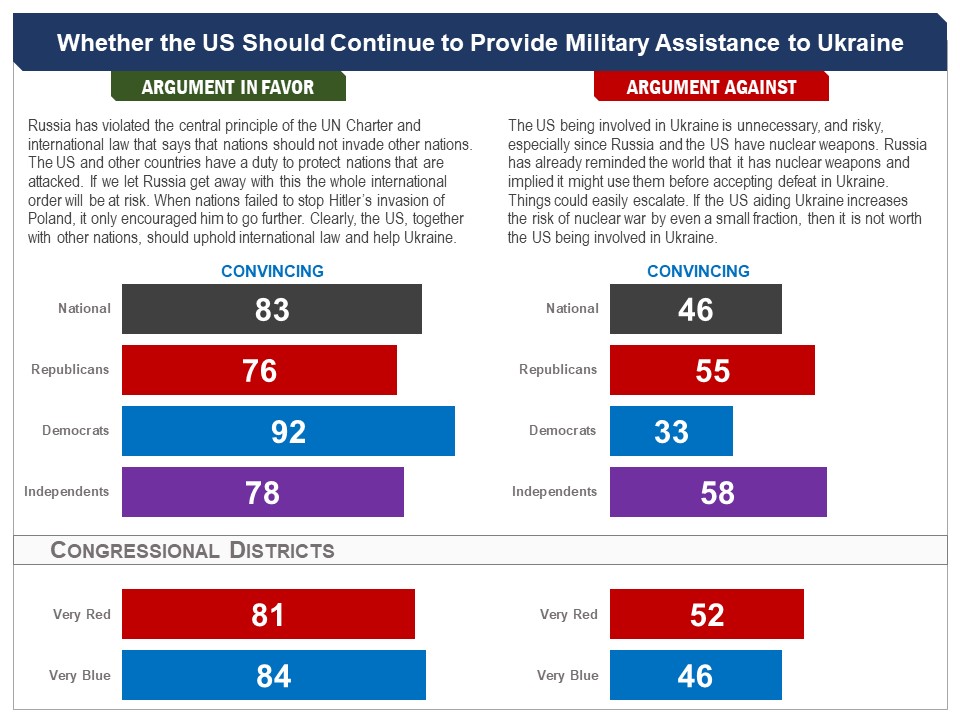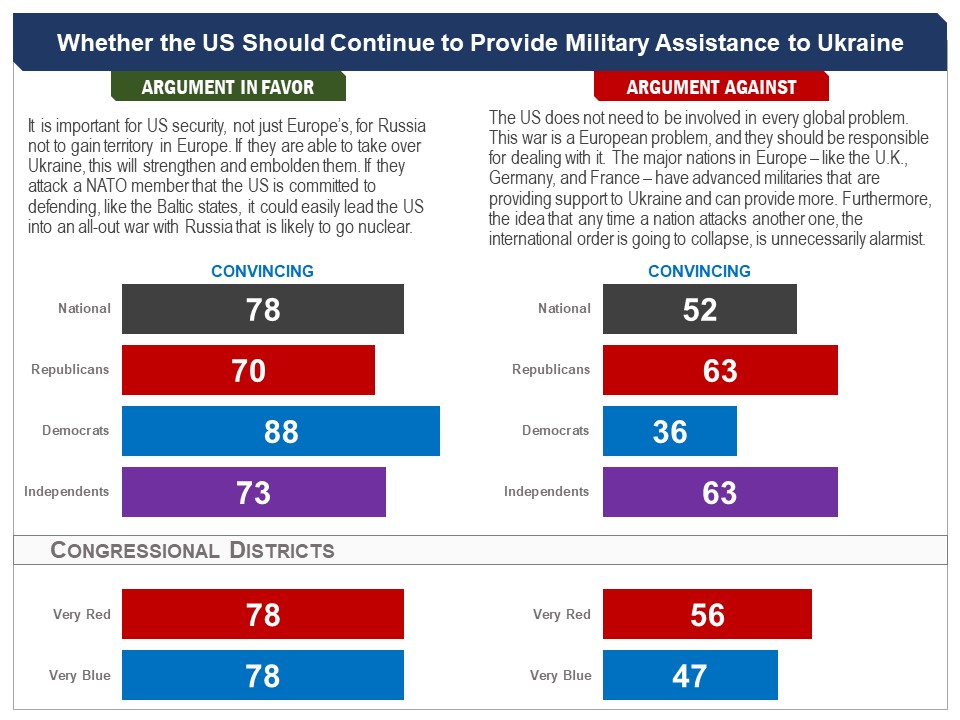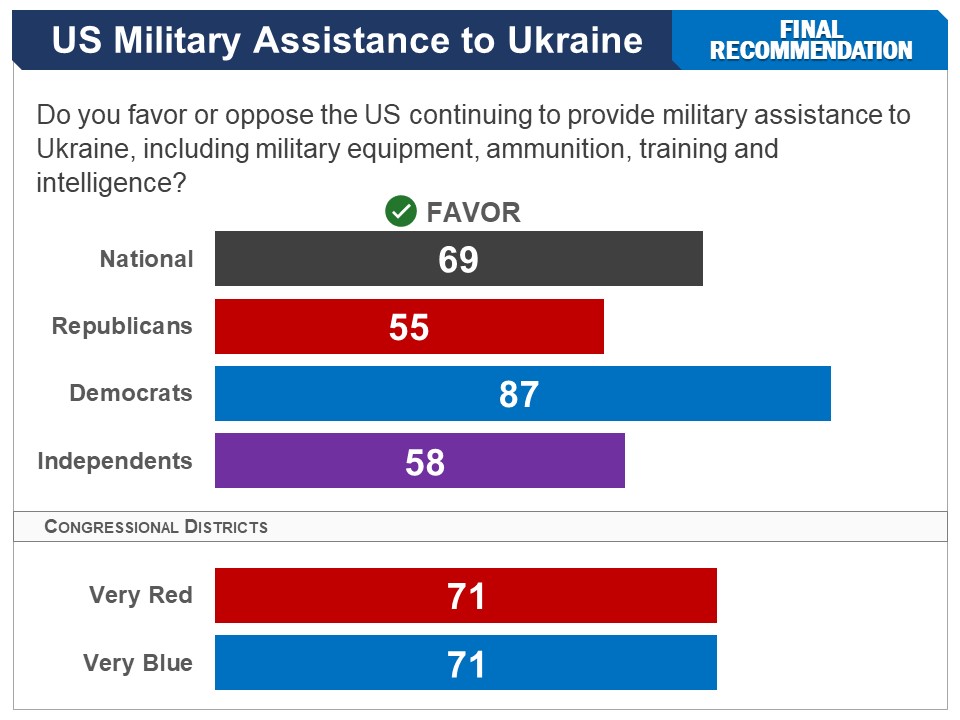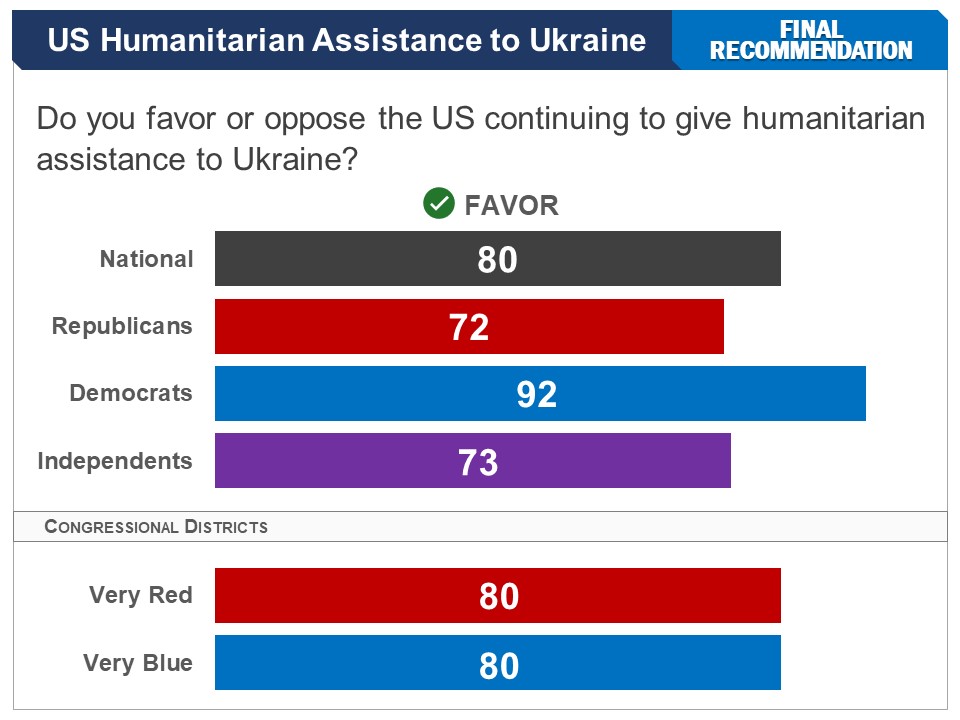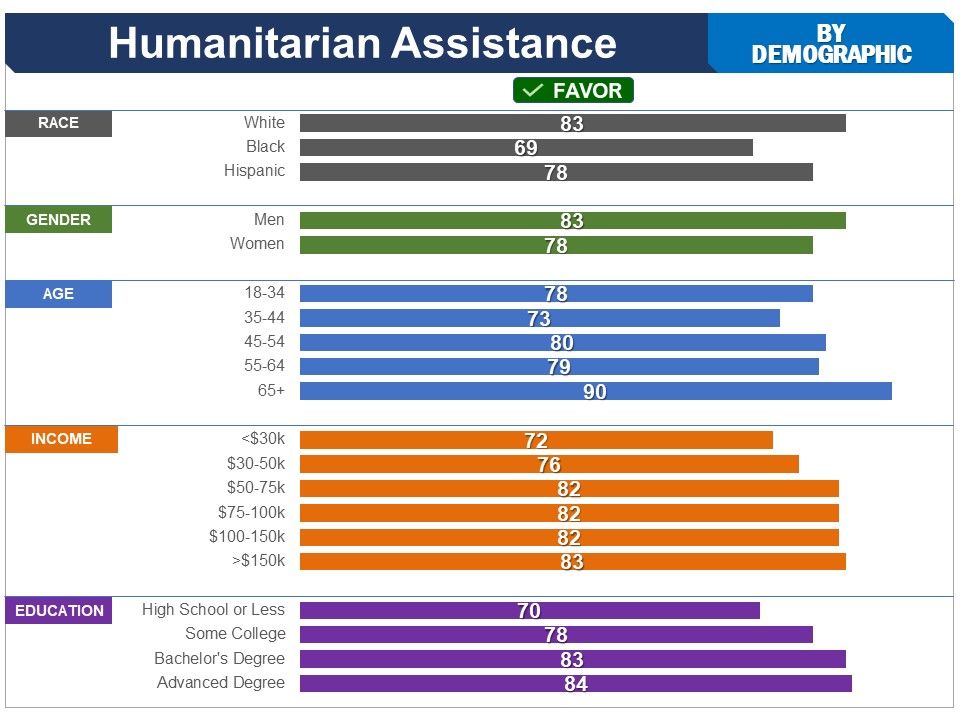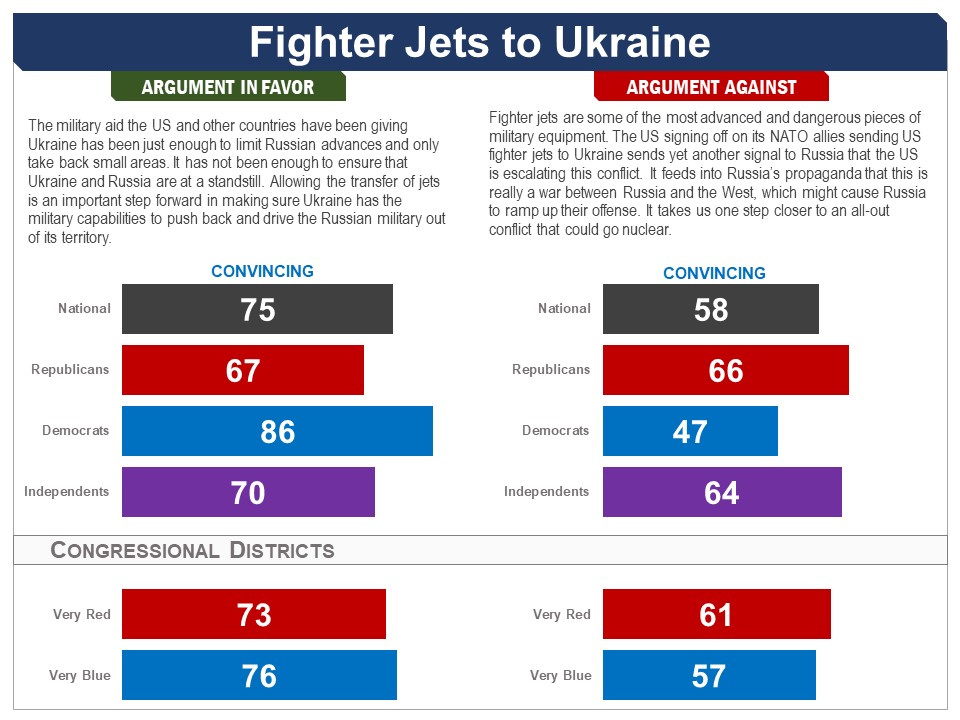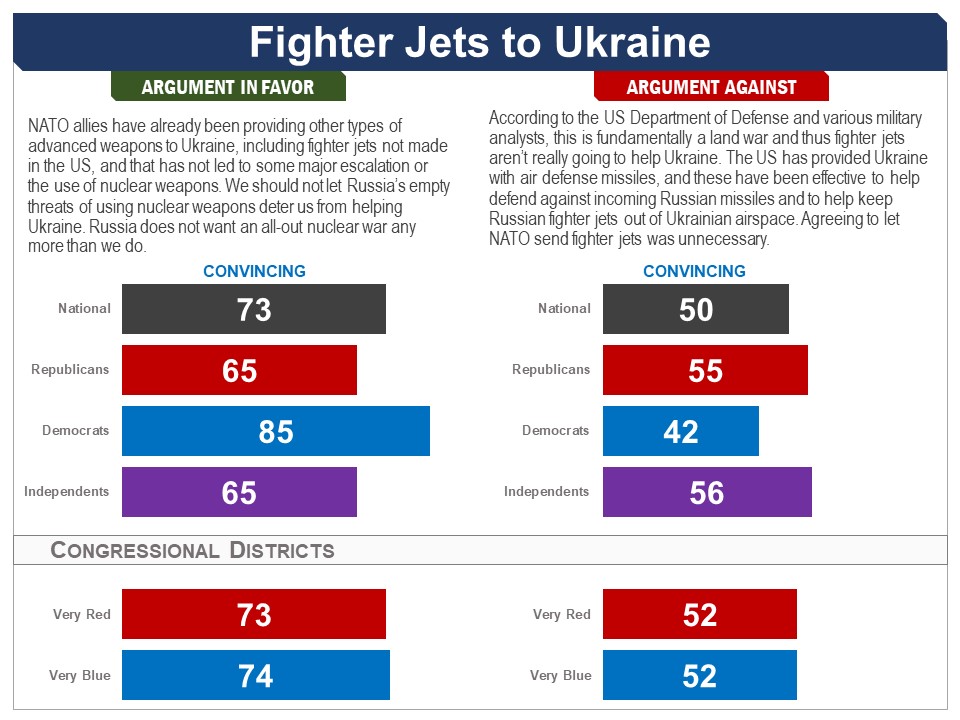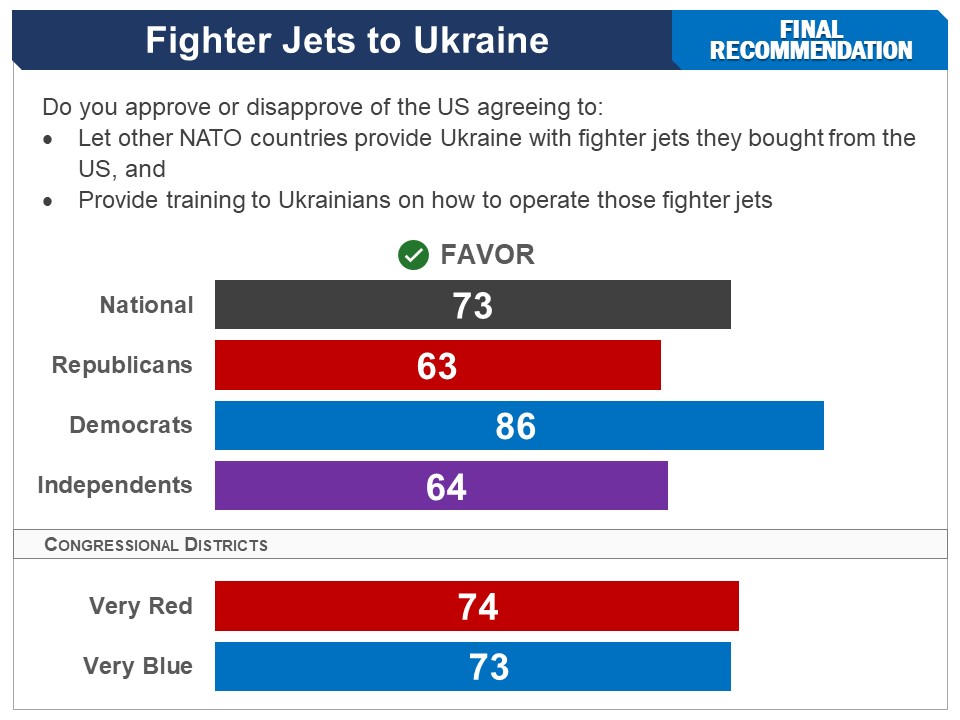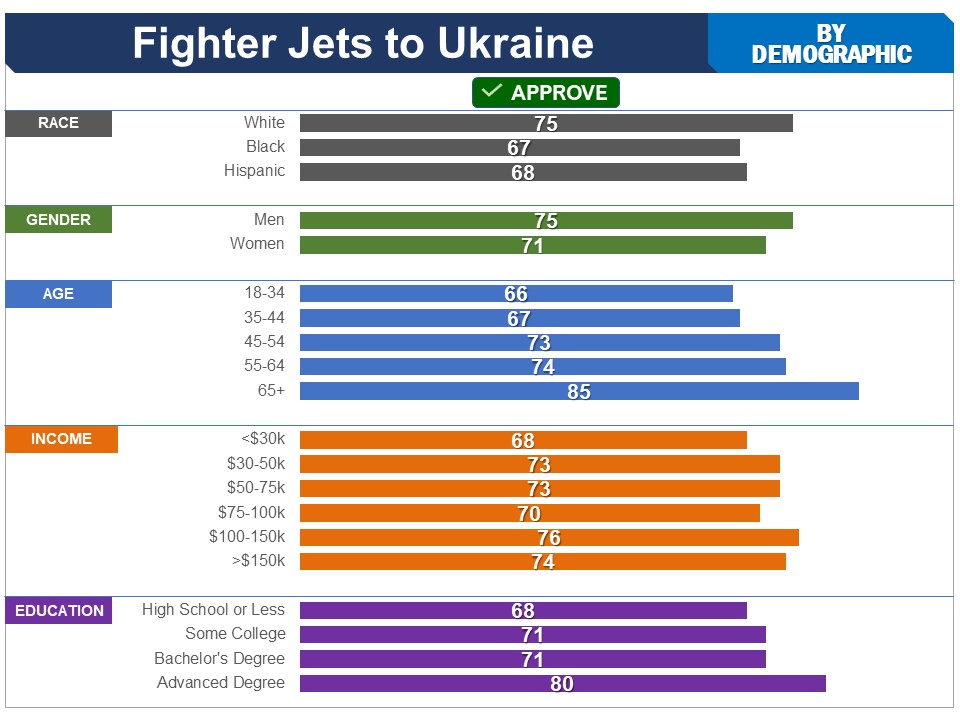
Ukraine-Russia War
In March of 2022, Russia launched a full invasion of Ukraine. The United Nations, including the US, quickly declared this invasion to be an act of aggression that violates Ukraine’s national sovereignty as guaranteed by the UN Charter. The invasion triggered a series of debates over the US’ role in this conflict:
- the degree of US intervention, if any;
- how to weigh any benefits of intervention against the risk of Russia escalating to nuclear attacks;
- whether to press Ukraine to enter peace negotiations, and if so, under what conditions.
- National Sample: 2,446 registered voters
- Margin of Error: +/- 2.0%
- Fielded: June 15-28, 2023
- Questionnaire with Frequencies
- Download Full Report
Proposals with bipartisan support discussed below include:
- The US continuing to provide military aid to Ukraine
- The US continuing to provide humanitarian aid to Ukraine
- US agreeing to let allies provide US-made fighter jets to Ukraine, and the US training Ukrainian pilots to operate them
One proposal received majority opposition, but it was not bipartisan:
- The US encouraging Ukraine to enter peace negotiations with Russia, whether or not Russia agrees to withdraw troops from Ukraine
For each proposal, respondents evaluated arguments for and against, rated the proposal on a 0-10 scale of acceptability (with 5 being “just tolerable”), and then made their final recommendation.
|
Respondents were provided a detailed briefing that included information about the history and circumstances leading up to Russia’s invasion of Ukraine, including perspectives on the role played by NATO, and the 2014 political uprising in Ukraine known as the Maidan Revolution and its aftermath. Respondents were first told: This survey will ask you questions about what you think US policy should be regarding the Ukraine-Russian war. As you may know, this conflict started in 2014 and escalated in 2022, when the Russian government launched a full-scale attack on Ukraine. You will have the opportunity to give your opinion on what US policy should be for the following:
They were provided information about Ukraine’s relation to Russia since the collapse of the Soviet Union, and the role that NATO expansion has played in that relationship: Ukraine shares a border with Russia. In the 1920s, Ukraine became one of the founding republics of the Soviet Union, along with Russia. In 1991, the Soviet Union came apart. Ukraine became an independent nation recognized by the United Nations, the US and Russia. Soon after, a number of Eastern European nations who were former members of the Soviet Union expressed interest in joining the military alliance NATO, which includes the US and many western European nations. US leaders were also encouraging them to join, while Russia was strongly opposed. In 1999 Poland, Hungary, and the Czech Republic became NATO members. In 2000, Vladimir Putin became President of Russia. He expressed strong concern that nations close to Russia were forming ties with the US and Western Europe. There has been a lot of controversy over NATO expansion. According to leaders of the Russian government, after the Soviet Union came apart, the US and other European leaders said NATO would not expand any closer to Russia. When NATO started accepting new members the Russian government felt that promise had been broken, and that their security was at risk. On the other side, US and Western European leaders have said they made no promise not to expand NATO closer to Russia, and that those nations chose to join NATO on their own. There is a debate among Western scholars about whether at the time the US made such promises, either implicitly or explicitly. When NATO said that the Republic of Georgia, which is on Russia’s border, could eventually become part of NATO, Russia expressed strong disapproval and increased its military presence in Georgia. This led to a military conflict. They were then informed about the divisions within Ukraine with regards to Ukraine’s alliances to Russia and Europe; and the 2014 political uprising known as the Maidan Revolution, and its aftermath: There has been a division within Ukraine, between those who want to increase ties with Europe, who are mainly in the western part of Ukraine, and those who want to increase ties with Russia, who are mainly in the eastern part. In 2013, the Ukrainian Parliament took steps toward joining the European Union. However, the President at the time blocked it. This contributed to a major political uprising in 2014. The Parliament removed the President, opening the door to moving closer to Europe. In response, the Russian government started amassing troops on the border of Ukraine. During this political uprising, groups in the eastern part of Ukraine that wanted to be closer to Russia overthrew their local governments, with Russian military assistance. Majorities in two areas voted to become independent, and one area – Crimea – voted to become part of Russia. However, these votes have been widely criticized because independent observers were not allowed to witness the vote counting, and Russian and pro-Russian military forces were present at the time of voting. The Russian government then incorporated Crimea into Russia. The Ukrainian government and most countries still consider these areas to be part of Ukraine. Since 2014, the Ukrainian government has been moving closer to Europe, which has been supported by a growing majority of the Ukrainian public. Ukraine is moving toward becoming part of the European Union. Ukraine is also making moves toward joining NATO and has been getting military training and weapons from NATO and participating in joint military exercises. Russia strongly opposed Ukraine moving closer to Europe and NATO and said that it threatened Russia’s vital security interests. They were informed of the 2022 invasion and the response by the international community: Then in February 2022, the Russian government launched a full attack on Ukraine. Russia’s stated intention was to overthrow the Ukrainian government and bring Ukraine closer to Russia. In response, the UN General Assembly condemned the attack as a violation of the UN Charter that prohibits Members from invading another state. The vote was 141 in favor and 5 opposed, with 47 abstaining or absent. China and India abstained and have not condemned the invasion. The US and several dozen other nations have:
Lastly, they were informed about the current state of the war (as of June 2023): Since the invasion, Russia has gained military control over about 15% of Ukraine. Russia has declared a large portion of the eastern part of Ukraine to now be part of Russia and has begun to incorporate those areas, for example by introducing Russian currency. The Ukrainian military has been surprisingly successful in stopping Russian advances, as well as taking back some areas that were captured by Russia. The US Defense Intelligence Agency estimates that the war has resulted in:
The UN estimates that about 13 million Ukrainians have fled their homes (about a third of the total Ukrainian population) to get away from the battles. |
|
Respondents were presented a briefing on US military assistance to Ukraine, as follows: We will now turn to a key question: whether the US should continue to provide military and other assistance to Ukraine. As you may know, the US has been providing the Ukrainian military: military equipment, ammunition, training and intelligence. It is difficult to put a dollar value on this assistance, as much of the military equipment provided is fairly old and used, but it is roughly some tens of billions of dollars. European countries have been providing an equivalent amount of military assistance. The first argument in favor, that Russia has violated international law which the US has a duty to uphold, did the best of any argument. It was found convincing by an overwhelming bipartisan majority of 83% (Republicans 76%, Democrats 92%). The first con argument, that US involvement risks escalating the conflict to a nuclear war, was found convincing by less than half (46%), including just 33% of Democrats but a majority of Republicans (55%) and independents (58%). Asked whether they favor, “the US continuing to provide military assistance to Ukraine, including military equipment, ammunition, training and intelligence,” 69% were in favor, including 55% of Republicans, 87% of Democrats and 58% of independents. Majorities in all types of congressional districts were in favor of continued military aid, from very red to very blue districts, with no significant variation.
When offered a non-committal option (e.g. not sure, neither favor nor oppose), around one-fifth choose that option, lowering the total percent in support.
When US support to help Ukraine fight against Russia is framed only in terms of financial assistance, without specifying how the funding would be used, a small majority or plurality are in support, but less than half of Republicans.
|
|
Respondents were presented the following: Both the US and European countries have also been giving Ukraine humanitarian aid, including providing food and shelter, and helping them repair access to water and electricity. So far, the US has given about $39 billion in such assistance. The Europeans have contributed an equivalent amount and have also accepted more than a million Ukrainian refugees into their countries. Another proposal is for the US to continue giving humanitarian assistance to Ukraine. Asked whether they favored, “the US continuing to give humanitarian assistance to Ukraine,” 80% were in favor, including 92% of Democrats, 72% of Republicans and 73% of independents. Majorities in all types of congressional districts were in favor of continued humanitarian aid, from very red to very blue districts, with no significant variation. |
|
There has been controversy over the US allowing US fighter jets to be transferred to Ukraine. Respondents were briefed on this topic, as follows: Now let’s turn to a specific type of military equipment that Ukraine has been asking the US and other NATO members for – fighter jets. Until recently only a few NATO countries provided a limited number of fighter jets to Ukraine, and Ukraine has asked for more. NATO countries did have more fighter jets they had bought from the US, but the US did not permit them to transfer them to Ukraine (A condition of the sale was that the US can say who they may transfer the jets to.) Recently, at the urging of other NATO members, the US shifted its positions and agreed to allow them to provide those fighter jets to Ukraine. The US also agreed to provide training to Ukrainian pilots on how to operate these fighter jets. Whether the US should have agreed to this has been debated. The first argument in support stated that this type of advanced military equipment is essential for Ukraine to push back Russian forces, and was found convincing by 75% (Republicans 67%, Democrats 86%). The argument against, that this sends an escalatory signal to Russia who could respond with a nuclear attack, was found convincing by 58%, including 66% of Republicans, but just 47% of Democrats.
Asked for their final recommendation, 73% approved, including 63% of Republicans, 86% of Democrats and 64% of independents. Majorities in all types of congressional districts were in favor of the fighter jet agreement, from very red to very blue districts, with no significant variation.
When asked about Ukraine getting other types of advanced weapons systems, most Americans have been in support. There are some partisan differences, with fewer Republicans in support, but still a majority or plurality.
|





